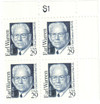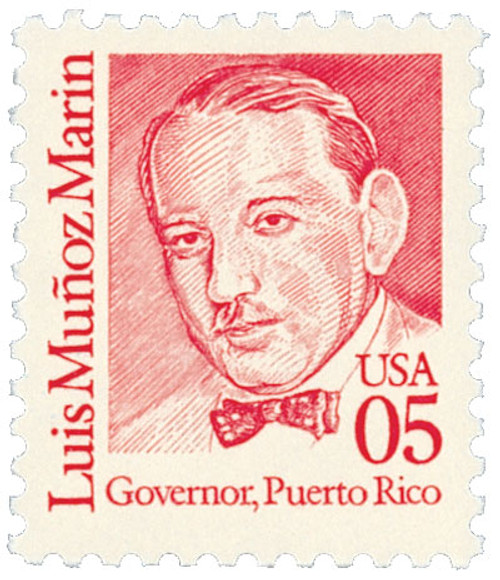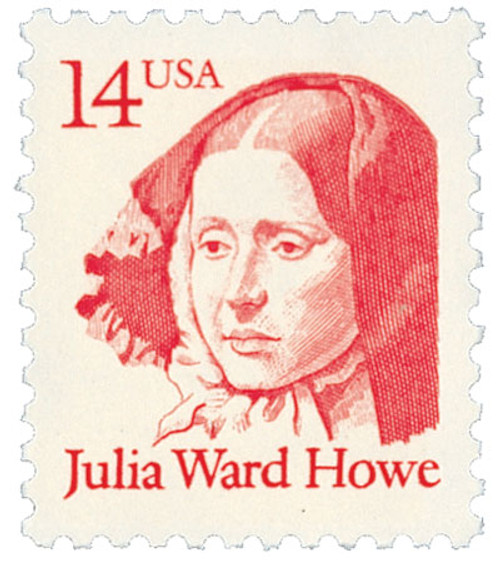
# 2184 - 1992 29c Great Americans: Earl Warren
US #2184
1992 Earl Warren
- Honors US Supreme Court Justice
- Part of the Great Americans Series
Category of Stamp: Definitive
Set: Great Americans
Value: 29¢, First-Class Mail rate
First Day of Issue: March 9, 1992
First Day City: Washington, DC
Quantity Issued: 250,000,000
Printed by: Canadian Bank Note Co. for Stamp Venturers
Printing Method/Format: Intaglio engraved
Perforations: 11
Color: Blue
Reason the stamp was issued: [Story of why the stamp was issued. Story of why the stamp was issued. Story of why the stamp was issued. Story of why the stamp was issued.]
About the stamp design: The style of this stamp is similar to others in the Great Americans series. Its image of Warren was done by Christopher Calle, the artist behind over 30 US stamps, including #2419, honoring the 20th anniversary of Apollo 11’s moon landing. The stamp is based on a 1967 photograph of Warren in his judicial robes. The dark background reflect the dark robes the Chief Justice wore.
Special design details: The stamp was engraved by Polish-born Czeslaw Slania, an internationally known stamp engraver.
About the printing process: The Warren stamp was printed by the Canadian Bank Note Company, a subcontractor with Stamp Venturers. The Canada-based company had printed the Dennis Chavez stamp (#2186) the previous year, causing a controversy among customers who wanted US stamps produced within the country. The Warren stamp was the last to be printed outside the US.
First Day City: The First Day of Issue ceremony took place in the Lower Great Hall of the US Supreme Court Building in Washington, DC. Chief Justice William Rehnquist, a stamp collector, was the guest speaker.
About the Great Americans Series: The Great Americans Series was created to replace the Americana Series. The new series would be characterized by a standard definitive size, simple design, and monochromatic colors.
This simple design included a portrait, “USA,” the denomination, the person’s name, and in some cases, their occupation or reason for recognition. The first stamp in the new series was issued on December 27, 1980. It honored Sequoyah and fulfilled the new international postcard rate that would go into effect in January 1981.
The Great Americans Series would honor a wider range of people than the previous Prominent Americans and Liberty Series. While those series mainly honored presidents and politicians, the Great Americans Series featured people from many fields and ethnicities. They were individuals who were leaders in education, the military, literature, the arts, and human and civil rights. Plus, while the previous series only honored a few women, the Great Americans featured 15 women. This was also the first definitive series to honor Native Americans, with five stamps.
The Bureau of Engraving and Printing (BEP) produced most of the stamps, but private firms printed some. Several stamps saw multiple printings. The result was many different varieties, with tagging being the key to understanding them. Though there were also differences in perforations, gum, paper, and ink color.
The final stamp in the series was issued on July 17, 1999, honoring Justin S. Morrill. Spanning 20 years, the Great Americans was the longest-running US definitive series. It was also the largest series of face-different stamps, with a total of 63.
History the stamp represents: The 14th Chief Justice of the United States, Earl Warren (1891-1974), was viewed as a courageous leader who sought to adapt accepted legal principles to modern social conditions. In 1954, he spoke for a unanimous court in the Brown vs. Board of Education case, one of the most important cases in Supreme Court history. He stated, “In the field of public education, the doctrine of ‘separate but equal’ has no place. Separate educational facilities are inherently unequal.”
Warren’s law career began when he graduated from University of California, Berkeley School of Law in 1914. Four years later, he was appointed a legislative assistant to a member of the California State Assembly. He was hired as a deputy district attorney of Alameda County in 1920 and was appointed district attorney five years later. In this position, Warren rooted out corruption in government.
The district attorney’s reputation grew as he rose in the ranks of California’s Republican Party. In 1938, he was elected Attorney General of California. Three years later, Warren ran a successful campaign for California’s governor. In this position, he improved the state’s highway system. He also participated in the founding of the United Nations, which took place in his state. Warren was re-elected as the governor two more times, making him the first governor of that state to be elected to three consecutive terms.
As Warren’s reputation grew, he set his sights on national politics. He ran for president beginning in 1944, but lost in the Republican primaries. After he was no longer in the 1952 race, he threw his support behind Dwight Eisenhower, the eventual winner of the presidency. As a reward for his support, Eisenhower promised he would nominate Warren to the Supreme Court if a vacancy arose. The opportunity arose in September 1953, when the Chief Justice died. Warren was appointed to the position the next month while Congress was in recess. He was confirmed by the Senate the following march.
During his 16 years as chief justice, many important cases were heard. These included Brown v. Board of Education, which desegregated schools. The Miranda v. Arizona case established a right to counsel for criminal suspects and instituted giving suspects a “Miranda warning.” His court also upheld the constitutionality of the landmark Civil Rights Act of 1964.
In December 1963, Warren was given the bleak task of heading an investigation into the assassination of President John Kennedy. Known as the Warren Commission, the investigation concluded in October 1964. Four years later, Chief Justice Warren decided to retire. It would be a year before that retirement became a reality. In his later years, Warren worked on his memoirs and accepted speaking engagements. On July 9, 1974, he died of a heart attack. Many consider Warren one of the most influential Chief Justices in the history of the US Supreme Court. His belief in equal justice for all was reflected in his many history-making decisions.
US #2184
1992 Earl Warren
- Honors US Supreme Court Justice
- Part of the Great Americans Series
Category of Stamp: Definitive
Set: Great Americans
Value: 29¢, First-Class Mail rate
First Day of Issue: March 9, 1992
First Day City: Washington, DC
Quantity Issued: 250,000,000
Printed by: Canadian Bank Note Co. for Stamp Venturers
Printing Method/Format: Intaglio engraved
Perforations: 11
Color: Blue
Reason the stamp was issued: [Story of why the stamp was issued. Story of why the stamp was issued. Story of why the stamp was issued. Story of why the stamp was issued.]
About the stamp design: The style of this stamp is similar to others in the Great Americans series. Its image of Warren was done by Christopher Calle, the artist behind over 30 US stamps, including #2419, honoring the 20th anniversary of Apollo 11’s moon landing. The stamp is based on a 1967 photograph of Warren in his judicial robes. The dark background reflect the dark robes the Chief Justice wore.
Special design details: The stamp was engraved by Polish-born Czeslaw Slania, an internationally known stamp engraver.
About the printing process: The Warren stamp was printed by the Canadian Bank Note Company, a subcontractor with Stamp Venturers. The Canada-based company had printed the Dennis Chavez stamp (#2186) the previous year, causing a controversy among customers who wanted US stamps produced within the country. The Warren stamp was the last to be printed outside the US.
First Day City: The First Day of Issue ceremony took place in the Lower Great Hall of the US Supreme Court Building in Washington, DC. Chief Justice William Rehnquist, a stamp collector, was the guest speaker.
About the Great Americans Series: The Great Americans Series was created to replace the Americana Series. The new series would be characterized by a standard definitive size, simple design, and monochromatic colors.
This simple design included a portrait, “USA,” the denomination, the person’s name, and in some cases, their occupation or reason for recognition. The first stamp in the new series was issued on December 27, 1980. It honored Sequoyah and fulfilled the new international postcard rate that would go into effect in January 1981.
The Great Americans Series would honor a wider range of people than the previous Prominent Americans and Liberty Series. While those series mainly honored presidents and politicians, the Great Americans Series featured people from many fields and ethnicities. They were individuals who were leaders in education, the military, literature, the arts, and human and civil rights. Plus, while the previous series only honored a few women, the Great Americans featured 15 women. This was also the first definitive series to honor Native Americans, with five stamps.
The Bureau of Engraving and Printing (BEP) produced most of the stamps, but private firms printed some. Several stamps saw multiple printings. The result was many different varieties, with tagging being the key to understanding them. Though there were also differences in perforations, gum, paper, and ink color.
The final stamp in the series was issued on July 17, 1999, honoring Justin S. Morrill. Spanning 20 years, the Great Americans was the longest-running US definitive series. It was also the largest series of face-different stamps, with a total of 63.
History the stamp represents: The 14th Chief Justice of the United States, Earl Warren (1891-1974), was viewed as a courageous leader who sought to adapt accepted legal principles to modern social conditions. In 1954, he spoke for a unanimous court in the Brown vs. Board of Education case, one of the most important cases in Supreme Court history. He stated, “In the field of public education, the doctrine of ‘separate but equal’ has no place. Separate educational facilities are inherently unequal.”
Warren’s law career began when he graduated from University of California, Berkeley School of Law in 1914. Four years later, he was appointed a legislative assistant to a member of the California State Assembly. He was hired as a deputy district attorney of Alameda County in 1920 and was appointed district attorney five years later. In this position, Warren rooted out corruption in government.
The district attorney’s reputation grew as he rose in the ranks of California’s Republican Party. In 1938, he was elected Attorney General of California. Three years later, Warren ran a successful campaign for California’s governor. In this position, he improved the state’s highway system. He also participated in the founding of the United Nations, which took place in his state. Warren was re-elected as the governor two more times, making him the first governor of that state to be elected to three consecutive terms.
As Warren’s reputation grew, he set his sights on national politics. He ran for president beginning in 1944, but lost in the Republican primaries. After he was no longer in the 1952 race, he threw his support behind Dwight Eisenhower, the eventual winner of the presidency. As a reward for his support, Eisenhower promised he would nominate Warren to the Supreme Court if a vacancy arose. The opportunity arose in September 1953, when the Chief Justice died. Warren was appointed to the position the next month while Congress was in recess. He was confirmed by the Senate the following march.
During his 16 years as chief justice, many important cases were heard. These included Brown v. Board of Education, which desegregated schools. The Miranda v. Arizona case established a right to counsel for criminal suspects and instituted giving suspects a “Miranda warning.” His court also upheld the constitutionality of the landmark Civil Rights Act of 1964.
In December 1963, Warren was given the bleak task of heading an investigation into the assassination of President John Kennedy. Known as the Warren Commission, the investigation concluded in October 1964. Four years later, Chief Justice Warren decided to retire. It would be a year before that retirement became a reality. In his later years, Warren worked on his memoirs and accepted speaking engagements. On July 9, 1974, he died of a heart attack. Many consider Warren one of the most influential Chief Justices in the history of the US Supreme Court. His belief in equal justice for all was reflected in his many history-making decisions.






















